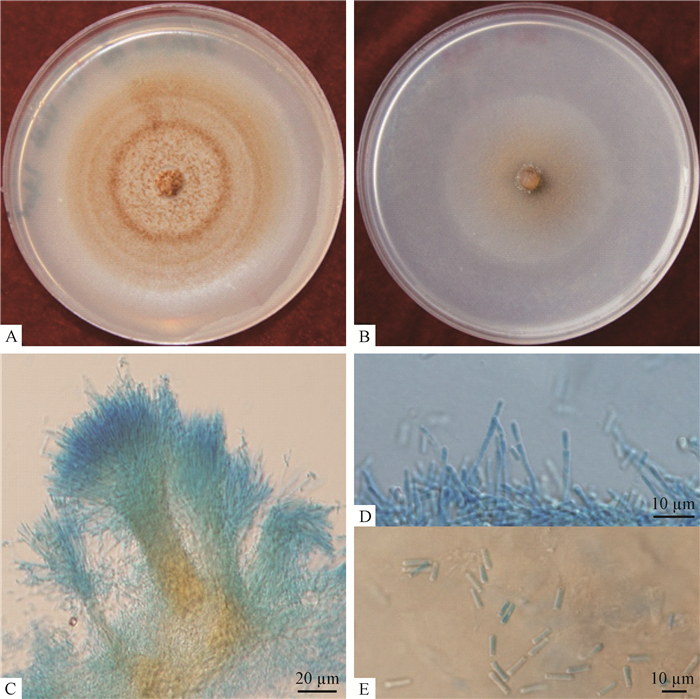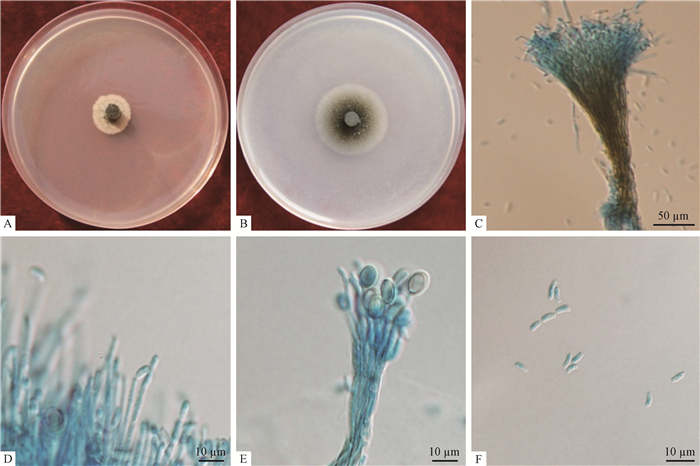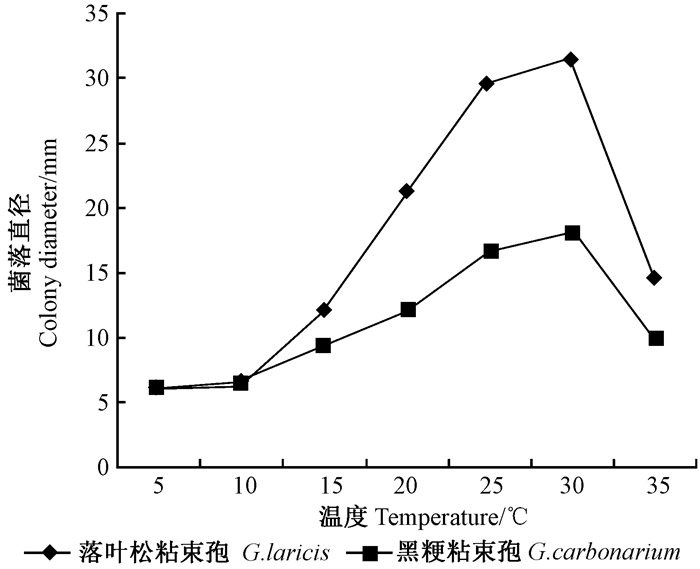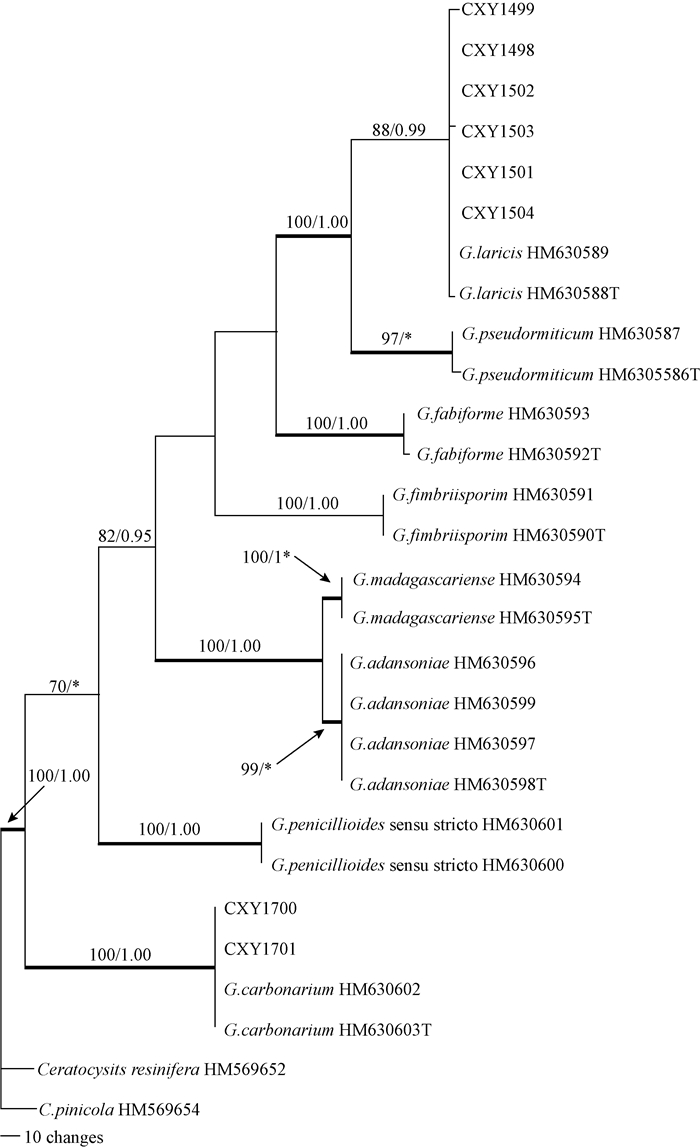文章信息
- 刘学伟, 吕全, 孟贤静, 白雪松, 黄国军, 李秀玲, 张星耀
- Liu Xuewei, Lü Quan, Meng Xianjing, Bai Xuesong, Huang Guojun, Li Xiuling, Zhang Xingyao
- 中国落叶松八齿小蠹伴生粘束孢属真菌的鉴定及其系统发育分析
- Identification and Phylogeny of Graphium spp. (Microascales: Graphiaceae) Associated with Ips subelongatus (Coleoptera: Scolytidae) in China
- 林业科学, 2016, 52(8): 76-87
- Scientia Silvae Sinicae, 2016, 52(8): 76-87.
- DOI: 10.11707/j.1001-7488.20160810
-
文章历史
- 收稿日期:2014-01-18
- 修回日期:2015-09-09
-
作者相关文章
2. 内蒙古赤峰市克什克腾旗广兴林场 克什克腾 025364;
3. 内蒙古赤峰市万方物业管理有限责任公司 赤峰 024000;
4. 辽宁省抚顺市抚顺县温道林场 抚顺 113113
2. Guangxing Forest Farm of Keshiketengqi in Chifeng, Inner Mongolia Keshiketeng 025364 ;
3. Wanfang Property Management Limited Liability Company in Chifeng, Inner Mongolia Chifeng 024000 ;
4. Wendao Forest Farm of Fushun County, Liaoning Province Fushun 113113
落叶松属(Larix spp.)植物在我国分布广泛,由于其具有抗旱、耐寒、生长快、木材价值高等特点,已成为我国速生丰产用材林基地建设的主要树种之一,并形成了大面积的人工纯林,具有重要的经济和生态价值。亚洲落叶松八齿小蠹(Ips subelongatus Motschulsky)是危害我国落叶松的主要害虫,其在侵害新伐倒木、濒死木的同时,也可危害健康木和衰弱活立木,对我国落叶松人工林造成了严重危害(殷惠芬等,1984; 萧刚柔,1992)。调查发现,亚洲落叶松八齿小蠹在我国分布范围较广(杨静莉等,2007),但主要危害在东北和华北异域分布的3种落叶松,即黑龙江省大、小兴安岭和内蒙古大兴安岭的兴安落叶松(L. gmelinii),黑龙江省东南部、吉林东部长白山地区以及辽宁省的长白落叶松(L. olgensis)及其在北京百花山、河北围场、内蒙古赤峰、承德雾灵山、山西五台山及恒山等高山地带的华北落叶松(L. principis-rupprechtii)(胡新生等,1999)。亚洲落叶松八齿小蠹在许多地区一直被认为是欧洲落叶松八齿小蠹(I. cembrae Heer)的同物异名,直到近年来依据线粒体DNA序列将二者清晰地区分开来,才重新确定为独立的一个种(Stauffer et al., 2001)。
在森林生态系统中,小蠹虫往往与某些真菌形成稳定的伴生关系,伴生真菌在削弱寄主树木抗性、协助小蠹虫侵害树木、维护小蠹虫种群动态等方面起着重要作用(叶辉,1997; Kirisits,2004; Klepzig et al., 2004; 吕全等,2008)。对小蠹虫伴生菌的研究已成为小蠹虫防治研究的一个重要方面,众多研究表明,与小蠹虫伴生的真菌包括子囊菌、担子菌、接合菌和有丝分裂孢子真菌(Kirisits,2004),其中长喙壳类真菌(ophiostomatoid fungi)为最主要的类群(Upadhyay,1981; Wingfield et al., 1993; Jacobs et al., 2001; Zipfel et al., 2006)。另外,还有许多粘束孢属(Graphium Corda)真菌如拟青霉粘束孢(Graphium penicillioides Corda)、链梗粘束孢(G. pseudormiticum M. Mouton & M. J.Wingf.)和落叶松粘束孢(G. laricis K. Jacobs, T. Kirisits et M. J.Wingf.)也能与小蠹虫形成伴生关系(Zipfel et al., 2006; Okada et al., 2000; Jacobs et al., 2003;Yamaoka et al., 2009)。
Corda(1837)根据模式种拟青霉粘束孢建立粘束孢属(Corda,1837),该属具有暗色的孢梗束并有大量单胞粘性分生孢子在顶端聚集的无性型特征(Okada et al., 2000)。有研究指出粘束孢属有160余种(赵桂华等,2009),但由于缺乏有性阶段并且无相关种比较标准,导致粘束孢属真菌的种很难鉴定,目前被大家接受的共19种(Seifert et al., 2011)。云杉长喙壳[Ophiostoma piceae(Münch)Syd. & P. Syd.]复合种(the species complex)菌丝束的无性型最初也被定义为粘束孢属(Crane et al., 1973),后基于对云杉长喙壳复合种的细致形态学比较和系统发育分析,Harrington等(2001)建议将云杉长喙壳复合种的无性型归入Pesotum属,而将粘束孢属归为具环痕的产孢细胞,是微囊菌属(Microascus)的无性阶段(Seifert et al., 1993; Okada et al., 1998; 2000)。
粘束孢属在微囊菌目(Microascales)中主要包括拟青霉粘束孢复合种和普尔顶粘束孢[G. putredinis(Corda)Hughes]种复合体。拟青霉粘束孢复合种主要包括落叶松粘束孢、拟青霉粘束孢等真菌,这些真菌主要从小蠹虫坑道和寄主木块中分离(Okada et al., 1998; Jacobs et al., 2003; Geldenhuis et al., 2004; Cruywagen et al., 2010); 普尔顶粘束孢种复合体在系统发育上与人类病原菌Parascedosporium,Petriella和Pseudallescheria具有亲缘关系(Issakainen et al., 1997; Okada et al., 2000;Gilgado et al., 2007)。
我国目前已记载的粘束孢属真菌大约有12种,如在中国云南松梢木蠹象(Pissodes sp.)上分离得到的链梗粘束孢和黑梗粘束孢(G. carbonarium Paciura, Z.W. de Beer, X.D.Zhou & M.J. Wingf.)(Paciura et al., 2010),在鹅耳枥属(Carpinus)和蔷薇属(Rosa)上分离得到的拟青霉粘束孢(魏景超,1979; 陆家云,2001; Xu et al., 2006),在阔叶树树皮及枯枝上分离得到的红头粘束孢(G. rhodophaeum Sacc. & Trott)(邓叔群,1963; 戴芳澜,1979);在土壤中分离得到球基生粘束孢(G. bulbicola P. Henn.)、普尔顶粘束孢和迪拜粘束孢(G. dubautiae F. Stevens&Weedon)等(许俊杰,2006; 赵桂华等,2009; 潘好芹,2009)。在我国分离到的粘束孢属真菌寄主多为植物和土壤,仅有2种真菌寄主为昆虫,但在小蠹虫上没有分离到。
目前在亚洲对落叶松八齿小蠹伴生菌的研究主要集中在长喙壳类真菌(Aoshima,1965;Yamaoka et al., 1998; 2009; Chung et al., 2006; 周秀华,2011a; 2011b; 孟贤静,2012),没有对粘束孢属伴生真菌进行研究。本研究通过对我国东北异域分布的3种落叶松林内齿小蠹伴生菌进行系统调查和分析,发现了粘束孢属真菌,并对粘束孢属菌株的形态学、生理学特性及系统发育进行初步研究,以期为研究其致病机制奠定基础,为控制森林病虫害提供依据。
1 材料与方法 1.1 真菌分离在内蒙古及东北三省等地区选择兴安落叶松、长白落叶松和华北落叶松进行标本采集,包括虫体标本与坑道标本,具体采集地点见表 1。
采用组织分离法对采集到的标本进行伴生真菌分离。利用1.5%的次氯酸钠溶液对落叶松八齿小蠹进行体表消毒1 min,用无菌的镊子将虫体置于2%水琼脂培养基上进行虫体表面真菌分离。将坑道标本切成4 mm×4 mm大小的组织块,用1.5%的次氯酸钠溶液(每100 mL含1滴吐温20)进行表面消毒1 min,用无菌水冲洗3次。采用无菌滤纸将组织块上的水分吸干后接在2%的无菌水琼脂培养基上。利用2%水琼脂培养基对组织块进行真菌分离培养。采用菌丝先端纯化法对组织分离培养的真菌进行纯化,纯化后得到的真菌采用2%MEA培养基进行培养,置于25 ℃恒温培养箱中,黑暗条件下培养。
1.2 菌株形态学将分离纯化得到的菌株在2%MEA培养基上培养30天,每天记录菌丝形态、生长情况,待其长出孢梗束释放出孢子后,在显微镜下观察菌株的孢梗束、分生孢子梗、分生孢子的形态特征,并进行描述、测量和拍摄。每一形态特征测量50组数据进行分析处理。
1.3 菌株生长速率测定采用直径6 mm的无菌打孔器在2%MEA培养基上旺盛生长的试验菌株菌落边缘切下菌饼。将菌饼置于相同培养基成分的培养皿中央,菌饼生长菌丝的一面与培养基直接接触,每菌株3个重复,5,10,15,20,25,30,35 ℃条件下恒温黑暗培养,每天观察记录菌落生长情况,采用十字交叉法测量菌落直径大小。
1.4 DNA提取及PCR扩增对纯化所得菌株采用2%液体PDA培养基置于25 ℃摇床下黑暗培养7天,挑取适量菌丝于滤纸上,用无菌水冲洗菌丝至滤液澄清,菌丝烘干,备用。DNA提取采用CTAB法用植物基因组DNA提取试剂盒进行提取,ITS 序列扩增引物为ITS1(5′-TCCGTAGGTGAACCTGCGG-3′)和ITS4(5′-TCCTCCGCTTATTGATATGC-3′),TEF-1α序列扩增引物为EF1F(5′-TGCGGTGGTATCGACAAGCGT-3′)和EF2R(5′-AGCATGTTGTCGCCGTTGAAG-3′)。试验采用25 μL的PCR反应体系: 模板1 μL,浓度1 μmol·L-1的引物各1 μL,2×Taq PCR MasterMix[0.1 U·μL-1 Taq Polymerase,500 μmol·L-1 dNTP each,20 mmol·L-1 Tris-HCL(pH8.3),100 mmol·L-1 KCl, 3 mmol·L-1 MgCl2]12.5 μL,ddH2O 9.5 μL。ITS 序列扩增程序为: 94 ℃ 3 min; 94 ℃ 1 min,55 ℃ 45 s,72 ℃ 1 min,循环35 次; 72 ℃ 4 min; TEF-1α序列扩增程序为: 95 ℃ 2 min,95 ℃ 30 s,56 ℃ 30 s,72 ℃ 1 min,循环35次; 72 ℃ 8 min。PCR产物采用2.2%琼脂糖凝胶电泳检测,条带单一、清晰的送往北京宝锐通生物科技有限公司进行双向测序。
1.5 系统发育分析在基因库(GenBank)内利用BLAST对上述获得的序列进行搜索比对,获得与已知序列初步的相关性,下载已正式发表序列,连同本试验获得菌株的核苷酸序列利用MAFFT在线进行序列比对。经过比对完成的序列利用最大简约法(PAUP* version 4.0b10)和贝叶斯方法(MrBayers3.1.2)进行系统发育分析,建立系统发育树。利用PAUP建树时采用启发式随机搜索(heuristic search),由序列长度多态位造成的碱基空位(gap)采用第五碱基的处理方法,分析条件为数二等分再连接(TBR)(Linnakoski et al., 2010)。贝叶斯系统发育树构建时采用MCMC算法,运行5 000 000代。模型的选择采用MrModeltest 2.3软件进行检测。构建基于ITS序列的系统发育树,选取同属微囊菌目的Ceratocystis resinifera和C. pinicola为外群(Harrington,2007; Reid et al., 2010)。试验所采用菌株及构建系统发育树所需参考菌株信息如表 1所示。
|
|

|
图 1 落叶松粘束孢形态学特征(CXY1502) Fig.1 Light micrographs of G. laricis(CXY1502) A:菌株在MEA培养基上25 ℃条件下培养22天的菌落形态Colony morphology of Graphium laricis on MEA at 25 ℃ for 22 d;B:菌株在OA培养基上25 ℃条件下培养8天的菌落形态Colony morphology of Graphium laricis on OA at 25 ℃ for 8 d;C:孢梗束Synnematous;D:产孢细胞Conidiogenous cells; E:分生孢子Conidia. |
试验从75份标本中获得真菌119株,其中8个菌株属于粘束孢属真菌(6株来自落叶松坑道,2株来自小蠹虫虫体)。进一步对该类菌株进行初步培养学归类和显微形态特征观察,分别与落叶松粘束孢和黑梗粘束孢2个种的形态特征吻合(Jacobs et al., 2003; Paciura et al., 2010)。
落叶松粘束孢(Graphium laricis K. Jacobs, T. Kirisits & M.J. Wingf.): 生长于2%MEA培养基上的落叶松粘束孢真菌菌丝白色,菌落边缘光滑,生长一段时间后,菌落中心向边缘变成红褐色。生长于OA培养基上的落叶松粘束孢真菌菌丝白色,菌落边缘光滑。粘性分生孢子群为红褐色,菌丝大多数埋生在培养基中,透明,光滑,膈膜处不收缩,宽2~5 μm。孢梗束单个或成簇地生长,基部微红色,向顶部逐渐变透明,长(103~)157±32(~218)μm,中间宽(10~)30 ± 2(~55)μm,顶端宽(18~)44 ±17(~88) μm。产孢细胞长(4~)11 ± 7(~21)μm,宽1.0~2.0 μm,环痕式产孢。分生孢子无隔膜,透明,圆柱形,基部明显平截,(1.72~7.36) μm ×(0.9~1.41)μm,如图 1所示。
黑梗粘束孢(G. carbonarium paciura, Z. W. de Beer, X. D. Zhou & M. T. Wingf.):生长于2%MEA培养基上的黑梗粘束孢真菌菌丝透明到橄榄绿,菌落浅黄色逐渐变深,边缘规则。生长于OA培养基上的黑梗粘束孢真菌菌丝白色,生长一段时间后菌落中间变为暗灰橄榄绿色。菌丝大多数埋生在培养基中,透明,光滑,膈膜处不收缩,宽2~3 μm。孢梗束长134~225(~300)μm,中间宽31~36(~43)μm,顶端宽40~58(~60)μm。分生孢子梗二轮分枝,产孢细胞2~4次轮生, 长15~18(~24)μm,宽1~3 μm,圆柱形至锥形,直有时微弯,有不显著的环痕。分生孢子[4~6(~7)]×[1~3]μm,透明,无隔膜,弯曲,顶端圆形,基部近截形至截形,如图 2所示。

|
图 2 黑梗粘束孢形态学特征(CXY1700) Fig.2 Light micrographs of G. carbonarium(CXY1700) A.菌株在MEA培养基上25 ℃条件下培养9天的菌落形态Colony morphology of Graphium penicillioides on MEA at 25 ℃ for 9 d;B.菌株在OA培养基上25 ℃条件下培养9天的菌落形态Colony morphology of G. carbonarium on OA at 25 ℃ for 9 d;C.孢梗束Synnematous;D.产孢细胞Conidiogenous cells;E. Scedosporium 无性型Scedosporium synanamorph;F. 分生孢子Conidia. |
落叶松粘束孢(CXY1498,CXY1499,CXY1501,CXY1502,CXY1503,CXY1504)、黑梗粘束孢(CXY1700,CXY1701)在5, 10, 15, 20, 25, 30和35 ℃, 2%MEA, 黑暗条件下第8天菌落直径如图 3所示。落叶松粘束孢菌株和黑梗粘束孢菌株在5,10 ℃条件生长缓慢,7天后有生长迹象。菌株在15 ℃条件下,于接种后第3天开始生长,且生长较为缓慢。20,25和35 ℃条件下,菌株于接种后第2天开始生长,且生长速度较快。比较发现,25 ℃比20 ℃和35 ℃温度下生长快,菌株在30 ℃条件下时生长速度最快。

|
图 3 粘束孢属菌株培养第8天菌落直径 Fig.3 Average colony diameters of the selected Graphium spp. isolates after 8 days |
将试验所得8个菌株的ITS序列与35条参比序列用MAFFT进行比对后构建最大简约系统发育树,分析结果显示,比对的574个序列特征视为无序且权重相同,其中恒量特征(constant characters)数目322个,简约无信息(parsimony-uninformative)变量特征33个,简约信息(parsimony-informative)数目219个。最大简约系统发育树长(Tree length)为457,一致性指标(Consistency index, CI)为0.789 9,相似指数(homoplasy index, HI)为0.210 1,保留指数(retention index, RI)为0.917 7,校正一致性指数(Rescaled consistency index, RC)为0.725 0。MP树表明共分为3个主要分支,其中菌株CXY1501,CXY1502,CXY1504,CXY1503,CXY1498和CXY1499与落叶松粘束孢聚为一支,节点支持率(BS)为96;菌株CXY1700和CXY1701单独聚为一支,与黑梗粘束孢亲缘关系较近。基于ITS基因的MP树4个分支的BS多数高于95%(图 4)。贝叶斯系统发育树的拓扑结构与PAUP构建的最大简约系统树完全一致。MP树节点支持率和贝叶斯系统发育树后验概率具体信息见图 4。

|
图 4 基于ITS序列构建的粘束孢属真菌系统发育树 Fig.4 Phylogenetic tree(MP Tree) of Graphium spp. based on the ITS sequences 图上所示为MP节点支持率和贝叶斯后验概率,支持率大于95演化枝加粗。Bootstrap value and Bayesian values are indicated at the branch nodes. Dark branches indicate posterior probabilities >95. |
将试验所得8个菌株的TEF1-α序列与20条参比序列用MAFFT进行比对后构建最大简约系统发育树,分析结果显示,536个特征视为无序且权重相同,其中恒量特征293个,简约信息数目227个。最大简约系统发育树长(tree length)为522,CI为0.766 3,HI为0.233 7,RI为0.918 1,RC为0.703 5。由图 5可知系统树共分为2个主要分支,其中菌株CXY1501,CXY1502,CXY1504,CXY1503,CXY1498和CXY1499与落叶松粘束孢聚为一支,BS为88; 菌株CXY1700和CXY1702与黑梗粘束孢聚为一支,BS为100。贝叶斯系统发育树的拓扑结构与PAUP构建的MP树基本一致。MP树节点支持率和贝叶斯系统发育树后验概率具体信息见图 5。

|
图 5 基于EF1-α序列构建的粘束孢属真菌MP系统发育树 Fig.5 Phylogenetic tree (MP Tree) of Graphium spp. based on the EF1-α sequences 图上所示为MP节点支持率和贝叶斯节点支持率,支持率大于95进化枝加粗。Bootstrap value and Bayesian values are indicated at the branch nodes. Dark branches indicate posterior probabilities >95. |
本研究对危害长白落叶松和华北落叶松八齿小蠹的虫体和坑道组织进行伴生真菌的分离纯化,对获得的粘束孢属菌株进行生理学特性、菌落特征、微观形态学的观察,以及基于rRNA-ITS和TEF-1α多位点DNA序列的系统发育分析。结果结果表明试验分离得到落叶松粘束孢菌株6株和黑梗粘束孢菌株2株,其中,落叶松粘束孢为我国新纪录种,落叶松粘束孢和黑梗粘束孢都是首次从亚洲落叶松八齿小蠹上分离到,为新的小蠹虫-真菌伴生关系。
落叶松粘束孢最早发现于奥地利,是在欧洲落叶松八齿小蠹和欧洲落叶松坑道上分离到的主要真菌之一,为弱寄主病原菌或腐生菌(Jacobs et al., 2003)。落叶松粘束孢与链梗粘束孢的亲缘关系很近,但二者在孢梗束长度和菌落颜色等形态学方面有很大区别(Mouton et al., 1994;Jacobs et al., 2003),并且前者目前仅在欧洲落叶松八齿小蠹上分离得到,后者的寄主为松十二齿小蠹(I. sexdentatus)、松直缝小蠹(I. typographus)等(Jacobs et al., 2003)。目前落叶松粘束孢仅在奥地利和苏格兰发现7株,在其他地区没有发现。本次研究在亚洲落叶松八齿小蠹和中国落叶松坑道中发现了落叶松粘束孢,不仅丰富了菌株数量,也扩大了落叶松粘束孢的分布范围。
系统发育分析时发现,本次试验所得菌株的ITS序列与黑梗粘束孢的差异较大(具有4个碱基的差异),但是TEF-1α序列无差异,而且形态学特征进一步支持了所得菌株为黑梗粘束孢。伴生菌适应寄主植物和小蠹虫的分化潜力已在不同地理(或寄主)种群中发现。本试验菌株的寄主是东北地区的落叶松八齿小蠹和在落叶松上分离到的,与之前的黑梗粘束孢参考菌株寄主是云南垂柳和云南松梢木蠹象(Paciura et al., 2010)二者的寄主生态位差别很大,解释了ITS序列出现差别的现象。菌株的ITS序列分析表明,黑梗粘束孢与截基粘束孢[G. basitruncatum(Matsush.)Seifert & G. Okada]的亲缘关系较近(图 4)。本次研究不仅增加了黑梗粘束孢的寄主种类,也扩大了寄主的分布范围。该种在我国的分布跨度区域巨大,可能是一个广泛分布的种。
落叶松粘束孢和黑梗粘束孢二者在形态上存在明显差异:落叶松粘束孢菌落中心向边缘变成红褐色,黑梗粘束孢菌落中间为暗灰橄榄绿色; 孢梗束形状及大小不同; 落叶松粘束孢分生孢子,圆柱形,基部明显平截,(1.72~7.36)μm ×(0.9~1.41)μm;而黑梗粘束孢分生孢子顶端圆形,基部近截形至截形[4~6(~7)]μm×[1~3]μm。
落叶松粘束孢和黑梗粘束孢都属于拟青霉粘束孢复合种,目前该种复合体包括9个已命名菌种(Okada et al., 2000; Geldenhuis et al., 2004; Hulcr et al., 2007; Massoumi Alamouti et al., 2007)。拟青霉粘束孢复合种中大多数真菌都是在虫体坑道和树木边材中分离到的,其中寄主为小蠹虫的有落叶松粘束孢、链梗粘束孢、G. fimbriisporum(M. Morelet)K. Jacobs, Kirisits & M.J. Wingf.及2种未命名的菌种(Jacobs et al., 2003; Geldenhuis et al., 2004; Hulcr et al., 2007; Paciura et al., 2010),但是寄主为落叶松八齿小蠹的伴生菌仅为落叶松粘束孢。
本研究发现了2种与落叶松八齿小蠹伴生的粘束孢属真菌,并对其形态学、生理特征及系统发育进行初步研究,接下来准备在野外进行人工接种试验来测定其致病性。尽管从已有报道看该类真菌很可能为弱寄生性,但针对我国北方分布的3种落叶松的致病性仍有待明确,而且与落叶松八齿小蠹间的伴生关系以及在危害寄主方面的协同作用仍需进一步的工作。
| [] |
戴芳澜. 1979. 中国真菌总汇. 北京: 科学出版社 : 972 .
( Dai F L. 1979. Sylloge fungorum sinicorum. Beijing: Science Press : 972 . [in Chinese] ) |
| [] |
邓叔群. 1963. 中国的真菌 : 138–142.
( Deng S Q.1963. Fungi of China : 138–142. [in Chinese] ) (  0) 0)
|
| [] |
胡新生, EnnosR A, 王笑山. 1999. 论我国兴安落叶松、长白落叶松及华北落叶松种间遗传进化关系. 林业科学 , 35 (3) : 84–96.
( Hu X S, Ennos R A, Wang X S.1999. On evolutionary relationships among three larix taxa in China: L. gmelinii (rupr.) rupr, L.olgensis Henry and L. principis-rupprechtii Mary. Scientia Silvae Sinicae , 35 (3) : 84–96. [in Chinese] ) (  0) 0)
|
| [] |
陆家云. 2001. 植物病原真菌学. 北京: 中国农业出版社 : 141 -164.
( Lu J Y. 2001. Plant Pathogenic Mycology. Beijing: Chinese Agricultural Press : 141 -164. [in Chinese] ) |
| [] |
吕全, 张星耀, 杨忠岐, 等. 2008. 红脂大小蠹伴生菌研究进展. 林业科学 , 44 (2) : 134–142.
( Lü Q, Zhang X Y, Yang Z Q, et al.2008. Progress in Study on the Fungi Associated with Dendroctonus valens. Scientia Silvae Sinicae , 44 (2) : 134–142. [in Chinese] ) (  0) 0)
|
| [] |
孟贤静.2012.中国落叶松八齿小蠹伴生的长喙壳真菌鉴定及其系统发育.北京:中国林业科学研究院硕士学位论文. ( Meng X J.2012.Identification and phylogeny of ophiostomatoid fungi associated with Ips subelongatus in China.Beijing.MS thesis of Chinese Academy of Forestry,1-96.[in Chinese][in Chinese]) http://cdmd.cnki.com.cn/article/cdmd-82201-1013378481.htm |
| [] |
潘好芹.2009.长江、黄河源头地区土壤中暗色丝孢菌物种多样性研究.泰安:山东农业大学博士学位论文,1-233. ( Pan H Q.2009.Species diversity of soil dematiaceous hyphomycetes from Yangtse River and Yellow River source area of China.Tai'an:PhD thesis of Shandong Agricultural University,1-233.[in Chinese][in Chinese]) |
| [] |
魏景超. 1979. 真菌鉴定手册. 上海: 上海科学技术出版社 : 136 -141.
( Wei J C. 1979. Fungal identification manual. Shanghai: Shanghai Science and Technology Press : 136 -141. [in Chinese] ) |
| [] |
萧刚柔. 1992. 中国森林昆虫. 北京: 中国林业出版社 .
( Xiao G R. 1992. Chinese Forestry Insects. Beijing: China Forestry Publishing House . [in Chinese] ) |
| [] |
许俊杰.2006.中国东南部地区及云南省土壤暗色丝孢菌分类研究.泰安:山东农业大学博士学位论文,1-293. ( Xu J J.2006.Taxonomic studies on soil dematiaceous hyphomycetes from southeastern zones and Yunnan Province of China.Tai'an:PhD thesis of Shandong Agricultural University,1-293.[in Chinese][in Chinese]) |
| [] |
杨静莉, 林强, 陈国发. 2007. 落叶松八齿小蠹的危险性分析. 东北林业大学学报 , 35 (3) : 60–63.
( Yang J L, Lin Q, Chen G F.2007. Risk analysis of Ips subelongatus Motsehulsky. Journal of Northeast Forestry University , 35 (3) : 60–63. [in Chinese] ) (  0) 0)
|
| [] |
叶辉. 1997. 小蠹虫伴生菌研究概况. 世界林业研究 , 10 (1) : 30–35.
( Ye H.1997. Research status of fungi associated with beetles. World Forestry Research , 10 (1) : 30–35. [in Chinese] ) (  0) 0)
|
| [] |
殷惠芬, 黄复生. 1984. 中国经济昆虫志. 北京: 科学技术出版社 : 54 -55.
( Yin H F, Huang F S. 1984. Economic insect fauna of China. Beijng: Science and Technology Press : 54 -55. [in Chinese] ) |
| [] |
赵桂华, 吴翠萍, 李彬, 等. 2009. 粘束孢属中国新记录种——普尔顶粘束孢菌. 东北林业大学学报 , 37 (3) : 112–113.
( Zhao G H, Wu C P, Li B, et al.2009. A new record species of genus Graphium Corda in China: Graphium putredinis (Corda) Hughes. Journal of Northeast Forestry University , 37 (3) : 112–113. [in Chinese] ) (  0) 0)
|
| [] |
周秀华, 宋瑞清, 曹翠, 等. 2011a. 落叶松八齿小蠹伴生真菌3个菌株的鉴定及生物学生理学特性. 林业科学 , 47 (5) : 82–86.
( Zhou X H, Song R Q, Cao C, et al.2011a. Identification and biological and physiological characteristics of 3 fungus strains associated with Ips subelongatus. Scientia Silvae Sinicae , 47 (5) : 82–86. [in Chinese] ) (  0) 0)
|
| [] |
周秀华, 宋瑞清, 周旭东, 等. 2011b. 落叶松八齿小蠹体内外和坑道内真菌类群. 菌物学报 , 30 (3) : 400–407.
( Zhou X H, Song R Q, Zhou X D, et al.2011b. Fungal population in the inside and outside of Ips subelongatus body and the gallary of insect-bored larch logs. Mycosystema , 30 (3) : 400–407. [in Chinese] ) (  0) 0)
|
| [] | Aoshima K.1965.Studies on wood-staining fungi of Japan.Philosophiae Doctor Thesis. |
| [] | Corda A C I.1837.Icones fungorum hucusque cognitorum.1.Published by the author,Prague,Czech Republic. |
| [] |
Chung W H, Kim J J, Yamaoka Y, et al.2006. Ophiostoma breviusculum sp.nov.(Ophiostomatales,Ascomycota) is a new species in the Ophiostoma piceae complex associated with bark beetles infesting larch in Japan. Mycologia , 98 (5) : 801–814.
DOI:10.3852/mycologia.98.5.801 ( 0) 0)
|
| [] |
Crane J L, Schoknecht J D.1973. Conidiogenesis in Ceratocystis ulmi,Ceratocystis piceae and Graphium penicillioides. American Journal of Botany , 60 (4) : 346–354.
DOI:10.2307/2441201 ( 0) 0)
|
| [] |
Cruywagen E M, de Beer Z W, Roux J, et al.2010. Three new Graphium species from baobab trees in South Africa and Madagascar. Persoonia , 25 (1) : 61–71.
DOI:10.3767/003158510X550368 ( 0) 0)
|
| [] |
Geldenhuis M M, Roux J, Montenegro F, et al.2004. Identification and pathogenicity of Graphium and Pesotum species from machete wounds on Schizolobium parahybum in Ecuador. Fungal Diversity , 15 (4) : 135–149.
( 0) 0)
|
| [] |
Gilgado F, Gene J, Cano J, et al.2007. Reclassification of Graphium tectonae as Parascedosporium tectonae gen.nov.,comb.nov.and Pseudallescheria fimeti as Lophotrichus fimeti comb.nov. International Journal Systematic and Evolutionary Microbiology , 57 (9) : 2171–2178.
DOI:10.1099/ijs.0.64958-0 ( 0) 0)
|
| [] |
Harrington TC, McNew D, Steimel J, et al.2001. Phylogeny and taxonomy of the Ophiostoma piceae complex and the Dutch elm disease fungi. Mycologia , 93 (1) : 111–136.
DOI:10.2307/3761610 ( 0) 0)
|
| [] | Harrington TC.2007.The genus Ceratocystis:Where does the oak wilt fungus fit? The Proceedings of the 2nd National Oak Wilt Symposium,27-41. |
| [] |
Hulcr J, Kolarik M, Kirkendall L R.2007. A new record of fungus-beetle symbiosis in Scolytodes bark beetles (Scolytinae,Curculionidae,Coleoptera). Symbiosis , 43 (3) : 151–159.
( 0) 0)
|
| [] |
Issakainen J, lava J, Eerola E, et al.1997. Relatedness of Pseudallescheria, Scedosporium and Graphium pro parte based on SSU rDNA sequences. Journal of Medical and Veterinary Mycology , 35 (6) : 389–398.
DOI:10.1080/02681219780001481 ( 0) 0)
|
| [] | Jacobs K,Wingfield M J.2001. Leptographium species-tree pathogens,insect associates and agents of blue-stain.American Phytopathological Society Press,St.Paul,MN,USA,224. |
| [] |
Jacobs K, Kirisits T, Wingfield M J.2003. Taxonomic re-evaluation of three related species of Graphium,based on morphology,ecology and phylogeny. Mycologia , 95 (4) : 714–727.
DOI:10.2307/3761947 ( 0) 0)
|
| [] |
Klepzig K D, Six D L.2004. Bark beetle-fungal symbiosis:Context dependency in complex associations. Symbiosis , 37 : 189–205.
( 0) 0)
|
| [] | Kirisits T.2004.Fungal associates of European bark beetles with special emphasis on the ophiostomatoid fungi//Lieutier F,Day K R,Battisti A, et al. Bark and wood boring insects in living trees in Europe,a synthesis.Kluwer Academic Press,the Netherlands,181-235. |
| [] |
Linnakoski R, De Beer Z W, Ahtiainen J, et al.2010. Ophiostoma spp.associated with pine-and spruce-infesting bark beetles in Finland and Russia. Persoonia:Molecular Phylogeny and Evolution of Fungi , 25 (1) : 72–93.
DOI:10.3767/003158510X550845 ( 0) 0)
|
| [] |
Massoumi Alamouti S, Kim J J, Humble L, et al.2007. Ophiostomatoid fungi associated with the northern spruce engraver, Ips perturbatus,in western Canada. Antonie van Leeuwenhoek , 91 : 19–34.
( 0) 0)
|
| [] |
Mouton M, Wingfield M J, van Wyk P W, et al.1994. Graphium pseudormiticum sp. nov.:a new hyphomycete with unusual conidiogenesis.Mycol Res , 98 (6) : 1272–1276.
( 0) 0)
|
| [] |
Okada G, Seifcrt K A, Takematsu A, et al.1998. A molecular phylogenetie reappraisal of the Graphium complex based on 18S rDNA sequences. Canadian Journal of Botany , 76 (9) : 1495–1506.
DOI:10.1139/b98-089 ( 0) 0)
|
| [] |
Okada G, Jacobs K, Kirisits T, et al.2000. Epitypification of Graphium penicillioides Corda,with comments on the phylogeny and taxonomy of Graphium-like synnematous fungi. Stud Mycol , 45 : 169–188.
( 0) 0)
|
| [] |
Paciura D, Zhou X D, De Beer Z W, et al.2010. Characterisation of synnematous bark beetle-associated fungi from China,including Graphium carbonarium sp.nov. Fungal Diversity , 40 (1) : 75–88.
DOI:10.1007/s13225-009-0004-x ( 0) 0)
|
| [] |
Reid J, Iranpour M, Rudski S M, et al.2010. A new conifer-inhabiting species of Ceratocystis from Norway. NRC Research Press , 88 : 971–983.
( 0) 0)
|
| [] |
Seifert K A, Okada G.1993. Graphium anamorphs of Ophiostoma species and similar anamorphs of other ascomycetes-Wingfield M J,Seifert K A,Webber J F. Ceratocystis and Ophiostoma:taxonomy,ecology and pathogenicity.St. Paul,Minnesota,USA:APS Press : 27–41.
( 0) 0)
|
| [] |
Seifert K A, Morgan-Jones G, Gams W, et al.2011. The Genera of Hyphomycetes. CBS Fungal Biodiversity Centre,the Netherlands : 229.
( 0) 0)
|
| [] |
Stauffer C, Kirisits T, Nussbaumer C, et al.2001. Phylogenetic relationships between the European and Asian eight spined larch bark beetle populations (Coleoptera,Scolytidae) inferred from DNA sequences and fungal associates. European Journal of Entomology , 98 (1) : 99–105.
DOI:10.14411/eje.2001.014 ( 0) 0)
|
| [] | Upadhyay H P.1981.A monograph of Ceratocystis and Ceratocystiopsis. University of Georgia Press,Athens,GA,USA,176. |
| [] | Wingfield M J,Seifert K A,Webber J F, et al.1993. Ceratocystis and Ophiostoma:Taxonomy,Ecology and Pathogenicity.American Phytopathological Society Press,St.Paul,MN,USA,293. |
| [] |
Xu J J, Zhang T Y.2006. Dematiaceous hyphomycetes from soil in Zhejiang Province,China I. Mycosystema , 25 (2) : 169–178.
( 0) 0)
|
| [] |
Yamaoka Y, Chung W H, Masuya H, et al.2009. Constant association of ophiostomatoid fungi with the bark beetle Ips subelongatus invading Japanese larch logs. Mycoscience , 50 (3) : 165–172.
DOI:10.1007/S10267-008-0468-7 ( 0) 0)
|
| [] |
Yamaoka Y, Wingfield M J, Ohsawa M, et al.1998. Ophiostomatoid fungi associated with Ips cembrae in Japan and their pathogenicity of Japanese larch. Mycoscience , 39 (4) : 367–378.
DOI:10.1007/BF02460897 ( 0) 0)
|
| [] |
Zipfel R D, De Beer Z W, Jacobs K, et al.2006. Multigene phylogenies define Ceratocystiopsis and Grosmannia distinct from Ophiostoma. Studies in Mycology , 55 : 77–99.
( 0) 0)
|
 2016, Vol. 52
2016, Vol. 52

